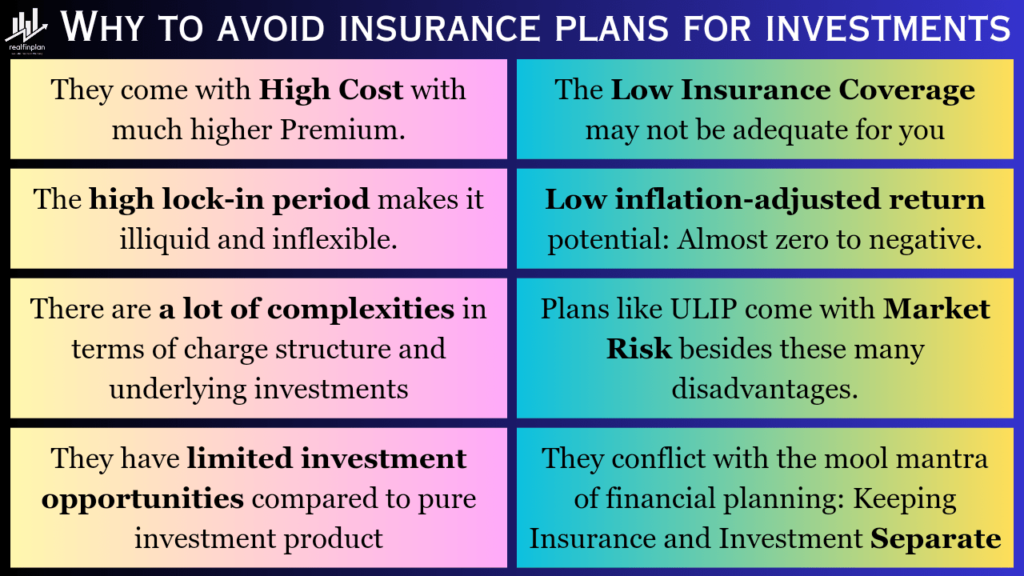Welcome to realfinplan! This article will try to understand “Why You Should Not Mix Insurance And Investment”. Insurance is for minimizing the risk and Investments are for our future needs and wants. Due to high cost, low insurance coverage, illiquidity, and almost zero to negative inflation-adjusted gains, the use of mixed products like insurance policies for investment can be a financial disaster.
Previously we discussed 7 Key Reasons To Avoid Insurance Plans For Investment Purposes. This article will be an extension of the previous post. Here, we will dive deeper into some mathematical illustrations to understand the concept of “not mixing insurance and investment”. So, let’s start.
Check out our other “What to Avoid” articles:
- Part 1: Why you should not run after returns? Rather Chase Target Corpus.
- Part 2: Why You Should Not Use Equity For Short-Term? Sequence Of Return Risk
- Part 3: Why Investment Planning Should Not Be Complicated And High Cost? – 9 Important Tips For Simple And Cost-Efficient Investment Planning
- Part 4: 7 Key Reasons To Avoid Insurance Plans For Investment Purposes
- Part 5: Limited Pay Vs Regular Pay Term Insurance: Why You Need To Avoid The 1st One
- Part 6: Term Insurance With Return Of Premium (TROP): The Unpleasant Truth Of Wasting Money In 2023
****************
In realfinplan, we provide realistic, authentic, unbiased, and free educational and news content, so that individuals can control their finances by themselves. I will request the readers
- First to Cover Your Basics: 3 Simple Steps To Manage Financial Risks For A Secure Future, then to understand the Basics of Saving and Investing: Saving vs Investing: The 2 Habits We Need To Master For A Prosperous Future.
- Second, identify your Goals and understand why we need Goal-Based Investment Planning: Investment Planning: Goal-Based Investing Basics – Why Do We Need It?
- Then move forward.
We have discussed earlier that Goal Based Investment Planning is not just a strategy, it’s more of a mindset shift. It gives you the purpose, the direction, and the momentum in investing. If you are critically disciplined, through goal-based investing you can lay a foundation for your investing process.
- Always remember, the sole purpose of our investing should be to Achieve the Target Corpus of a particular Goal, not a Target Return. And to achieve that target Corpus you need to have a Simple and Cost Effective Investment Planning.
- If you want to become financially stable and wealthy, you will need equity as an investment vehicle. Why? Because Equity has the potential to beat Inflation. But before we invest in it, we need to consider the risk involved: Sequence of Returns Risk (SRR) – Why To Avoid Equity For Short-Term.
- We need to adopt a proper strategy to challenge this Sequence of Returns Risk and counter its effects. Asset Allocation Strategy with Regular Rebalancing and a Glide Path is the key, the best weapon against Sequence of Returns Risk.
*********************
Table of Contents
Previously we discussed 7 Key Reasons To Avoid Insurance Plans For Investment Purposes. If we summarise the previous article, the disadvantages of mixing insurance and investment will be as follows:

Why You Should Not Mix Insurance And Investment? An Illustration
We have already discussed the damage done by mixing insurance and investment in our other articles:
- Part 5: Limited Pay Vs Regular Pay Term Insurance: Why You Need To Avoid The 1st One
- Part 6: Term Insurance With Return Of Premium (TROP): The Unpleasant Truth Of Wasting Money In 2023
The calculations done in those articles are based on NPV or the Net Present Value. There are other ways to understand the concept of “not mixing insurance and investment”, like considering CAGR or IRR. But we will try to understand things in a simple way and without any deep concepts like NPV, CAGR, IRR, or XIRR.
For calculation purposes, we have taken a benefit illustration of the
- LIC New Jeevan Anand – an endowment plan.
- LIC New Tech Term – a pure-term plan
You can easily visit the LIC website and generate a customized benefit illustration of a particular insurance plan in the “Quick Quotes” section. The benefit illustration I used is given below, you can download it and get some idea about the above-mentioned endowment plan.
Benefit Illustration: New Jeevan Anand Vs New Tech Term
- Age: 30 years (non-smoker)
- Policy term: 30 years
| Features | New Jeevan Anand | New Tech Term |
|---|---|---|
| Basic Sum assured on Death (During Policy Term) | ₹12,50,000 | ₹10000000 (₹1CR) |
| Basic Sum assured on Death (After Policy Term) | ₹10,00,000 | ₹0 |
| Monthly Premium (Excluding Tax) | ₹2929 | ₹972 |
| Yearly Premium (Excluding Tax) | ₹35,148 | ₹11,658 |
| Benefits when you outlive the policy term | ||
| Guaranteed Maturity Benefits (A) | ₹1,00,000 | |
| Non-Guaranteed Maturity Benefits or Simple Reversionary Bonus @ 8% (B) | ₹9,60,000 | |
| Total Maturity Benefits (C) (Guaranteed + Non-Guaranteed) (C = A+B) | ₹10,60,000 | |
| Final Additional Bonus (FAB) | ₹11,40,000 | |
| Total Maturity Benefits including FAB (A+B+FAB) | ₹22,00,000 |
In our calculation, we will compare 2 options here:
- Buying LIC New Jeevan Anand plan for Monthly Premium (Excluding Tax): ₹2,929
- Buying LIC New Tech Term for Monthly Premium (Excluding Tax): ₹972 and investing the difference amount of ₹2,000 as SIP in a Nifty 50 index fund (assumed post-tax return = 9%)
After 30 years when you outlive the policy term:
New Jeevan Anand
- Investment: ₹2929/month = ₹35,148/year
- Maturity Value: (Guaranteed + Non-Guaranteed) + (FAB) = ₹10,60,000 + ₹11,40,000 = ₹22,00,000
Let’s assume that LIC is a very generous company and they will give double the FAB as per their illustration. Let’s take it as ₹22,80,000.
- Then the total maturity value will be = ₹33,40,000
Insurance Coverage after death: ₹10,00,000
LIC’s New Tech Term + Nifty 50 Index Fund (Post-Tax Return expectation @ 9%)
- Term Insurance Premium: ₹972/month = ₹11,658/year
- Investment (Monthly SIP): ₹2,000/month = ₹24,000/year
- Total = ₹35,658/year
- Investment Value @ 9% after 30 years: ₹34,30,860
You can see that, even if you have very high expectations from LIC (close to impossible) and post-tax return expectation from nifty 50 index fund is pretty much conservative with 9% only, you will still end up with a higher corpus at the end of the policy term.
If you die after 20 years:
New Jeevan Anand
- Basic Sum Assured (BSA) on Death (A) (During Policy Term): ₹12,50,000
- Non-Guaranteed Maturity Benefits or Simple Reversionary Bonus @ 8% (B): ₹6,40,000
- FAB as per Illustration (C): ₹25,000
- Total Death Benefits (A+B+C): ₹19,15,000
Now, again let’s assume that LIC is a very generous company and they will give the FAB equal to the Simple Reversionary Bonus = ₹6,40,000
- Then Total Death Benefits = ₹12,50,000 (A) + ₹6,40,000 (B) + ₹6,40,000 (FAB) = ₹25,30,000
LIC’s New Tech Term + Nifty 50 Index Fund
- Your nominee gets the BSA of Term Insurance: ₹1,00,00,000
- From the Nifty 50 Index Fund (@ 9%), your nominee will get: ₹12,87,700
- Total Benefit = ₹1,12,87,700
Please recognize that, in our calculation, the expected return from the nifty 50 index fund is pretty much conservative and the return expectation from the insurance policy discussed above is pretty much on the higher side.
Now, please tell me which option is better.
Besides this, you should also think about all the complexities that come with an endowment plan. Ask yourself the following questions:
- Why is the maturity value of the policy so much lower?
- How is the mutual fund corpus so much higher than that of the returns of insurance plans?
- What is the nature of bonuses offered by these policies?
- What do you mean by a simple reversionary bonus?
- How do all the bonuses are calculated? Based on simple interest or compound interest?
- How do the insurance companies provide you the bonuses?
- How do the insurance companies use your money?
All the return parameters related to an insurance plan are pretty complicated and never easy to understand. Then why waste your time and money on these kinds of mixed products?
Conclusion
Yes, these insurance plans may come with tax-efficient gains but they come with high cost, low insurance coverage, complexities, illiquidity, and almost zero to negative inflation-adjusted gains. Then why go for a mixed complicated product?
- Keep it simple. Keep them separate.
A combination of various investment products like equity mutual funds, debt mutual funds, stocks, and fixed deposits, can be better options for investment planning.
- A good mix of these products can offer better potential for wealth creation over the long term.
- By using pure investment products you can tailor your investment strategy to your risk tolerance and financial goals.
You can get higher returns and more comprehensive insurance coverage by opting for a pure-term life insurance plan and separate investment products.
Check out our other “What to Avoid” articles:
- Part 1: Why you should not run after returns? Rather Chase Target Corpus.
- Part 2: Why You Should Not Use Equity For Short-Term? Sequence Of Return Risk
- Part 3: Why Investment Planning Should Not Be Complicated And High Cost? – 9 Important Tips For Simple And Cost-Efficient Investment Planning
- Part 4: 7 Key Reasons To Avoid Insurance Plans For Investment Purposes
- Part 5: Limited Pay Vs Regular Pay Term Insurance: Why You Need To Avoid The 1st One

